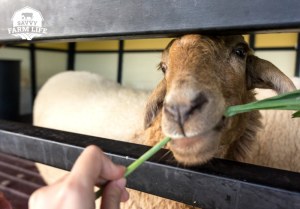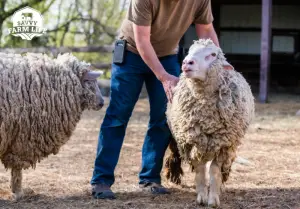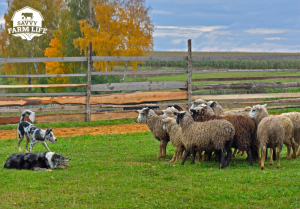How To Tame A Sheep
Sheep can be calm, loving, and docile animals to keep on your farm. However, not all sheep are born with a human-friendly demeanor. Some can be skittish or nervous around humans from the get-go. So, you may be wondering, how do I train my sheep to be comfortable around me? In other words, how do I tame my flock of sheep?
There are a few important things to remember when training sheep. The first is that it’s necessary to have patience and be repetitive with your training. Repetition is the number one tool that you can employ to help your sheep create associations between actions and rewards.
These associations will help them learn to perform repetitive behaviors for treats and food, thus “training” them! Most important is to be calm, collected, and patient, as training your sheep can be an arduous task that requires a lot of repetition in order for them to fully understand what you’re trying to accomplish.
Basic Principles of Sheep Taming and Training
Before you begin to create a plan for training your sheep, you have to think about your goals for the training. Do you want them to become more comfortable around humans? Do you want them to be able to wear a halter with no issues? Do you simply want them to come when you call?
All of these tasks can be easily accomplished with the proper training techniques. Once you have a goal in mind, it’s time to develop a plan of action. Sheep respond best to something called motivational training, instead of negative reinforcement training. Negative reinforcement training is when you take away an unpleasant effect when the animal in question accomplishes what you want them to.
In dogs, this could be an electric collar that’s turned on until the dog follows your command to sit. When they follow your command, the collar is turned off and they are released from the adverse effect that they’ve been subject to. Now, this isn’t the best way to train your sheep for a few reasons, but the biggest is that they respond much better to motivational sheep training techniques than other training methods. Motivational training is the act of rewarding an animal for following your command or completing the action that you requested of them.
For example, giving a sheep a treat when they allow you to pet them without protest. This will help to create an association between petting and treats, which, in turn, motivates them to be pet because they know they will get treats for it. Lastly, as with most animals, it’s easiest to train sheep when they are young and impressionable. Just like the saying goes, “You can’t teach an old dog new tricks”, these same rules apply to sheep. Though, unlike the saying, you can train older sheep, it will be a much longer, harder process than if you had trained the sheep as a lamb.
Training Sheep To Be Comfortable Around You
Given that you will be the one training your flock of sheep, it’s important that the sheep are comfortable around you before you begin. Some sheep can be skittish and nervous around humans at first, so it’s important to slowly ease them into human contact. This is where the whole “being patient” part can be key.
To start off, you’ll want to keep your sheep in a smaller pen when approaching them early on. This will make it harder for them to run away from you and, thus, easier to corral. Basically, it will force your sheep to be close to you!
Using Food as a Reward When Training Sheep 
Next, depending on how skittish your sheep are at first, you’ll want to start by creating an association between yourself and their food. For example, at feeding times, you can rattle their bucket of food and simultaneously call them to you. This will create an association in the sheep’s mind between you calling them and food, which is a good thing.
Next, when they actually approach you for feeding, you can hold the bucket in your hands or place it on the ground next to you. This will further strengthen the connection between you and the food in your sheep’s mind.
Once the sheep seem relatively comfortable with you, you can begin feeding them out of your hands. By feeding them directly, you will strengthen the bond between you and the sheep, while also helping them to bolster the connection between you and food!
While feeding your sheep, you can scratch them under their chins or on their necks. This will help them adjust to physical contact with human beings. They usually like being scratched under their heads, simply because their natural reaction to being tapped or touched on the top of their heads is to butt away in a defensive manner. Start by touching them gently under their chins, then progressing to the top of their head to see if they enjoy it.
Making Yourself Smaller When Training Sheep
Another easy way to make yourself seem more approachable to a skittish sheep is to bend down to their level. Think about how your sheep sees you; it will be a lot less intimidating to have a person at their eye level than to have someone towering over them.
In addition to this, try not to make any sudden movements, as these can scare your sheep into running away from you. Sheep are prey in the wild, meaning they startle easily as a defense mechanism against predators. Make sure your sheep see you as a fellow friend, and not as a fast-moving predator by keeping your actions slow and controlled.
The most important thing to remember when taming your sheep is to be patient. It may take frequent exposure to yourself and/or other humans for the sheep to feel comfortable approaching you. Just keep doing everything I’ve told you to do so far, over and over again, and your sheep will eventually get the gist. Be patient and be repetitive; they will understand with time that you’re a safe human!
What Treats Should I Give to My Sheep When Training them?
Now that you understand how food and treats can play a big role in motivational training for sheep, you may be wondering what kinds of treats are safe for sheep to eat?
Sheep are herbivores, so they typically consume a diet that consists of grass. In the wild, they will graze on grass and other various plant material to sustain themselves. In farm environments, they can eat everything from dry clover to hay and silage in addition to grazing the fields. However, if sheep eat grass all the time, what makes a good treat to use as a motivational tool for training?
Sheep can safely consume apples and carrots, though it may be an adjustment for them at first. They might reject these foods right away because they’re unfamiliar and don’t look like grass! But, with repeated exposure, your sheep will surely come to love these crunchy fruits and vegetables.
However, on the off chance that they don’t appreciate apples and carrots, this blogger describes “horse crunchies” as her flock of sheep’s favorite treat. Horse crunchies can be found at your local feed store and usually contain a blend of alfalfa, oats, and carrots. Just be sure to look at the ingredient list before feeding these to your sheep to ensure that there’s no copper or other yucky materials that may harm your flock.
Sheep Halter Training 
Some sheep owners may decide to halter train their flock for added control and easy movement. Halter training, for the uninitiated, is basically like training a dog to walk properly on a leash. It involves placing a halter over your sheep’s head, then attaching a lead to it in order to guide your sheep from one area to another.
Halter training can be a lengthy process depending on how comfortable your sheep is with the halter at first. However, as with any sheep training you do, it’s important to be patient and calm during the process.
Create A Positive Association
You can start by creating an association between food and the halter, similarly to how you created an association between yourself and food to get your sheep comfortable with you in the beginning. You can place the halter near and around their food, then, when they seem comfortable with it, you can progress to placing the halter on top of their heads.
If they resist at first, this is normal, so don’t be discouraged. You may need to gently restrain them in order to get the halter on their heads, but just be sure to do this safely and without endangering yourself. Once the halter is on their head, be sure to reward them with plenty of treats to continue the associations you’ve begun to create.
I want to interject briefly to clarify that this process should be drawn out over the course of several days, even months if necessary. Take time to create the association between the halter and food, then take even longer to get your sheep comfortable enough to put the halter on its head. After you get the halter on its head, give them a treat, then take it off again. Repeat this process until they seem fully comfortable with wearing the halter.
Lead Training
Once they are comfortable wearing the halter, you can begin the process of lead training them, aka gently guiding them with a rope that’s attached to the halter. The keyword here is gentle; you must be gentle when adjusting your sheep to the lead. Give them a soft coax forward in your direction before rewarding them with food and a release of the pressure on the halter. Once again, with time and patience, you will be able to train your sheep to follow you with their halters.
If you’re seriously considering halter training your sheep, there are plenty of resources on the internet to look into, including videos, other blog posts, etc, that will dive into more detail about the dos and don’ts of this process. I would highly recommend that you do a thorough job of researching proper techniques before seriously committing to a halter training program.
If you’d like to learn more about training and working with sheep, you can find more of my articles here!

